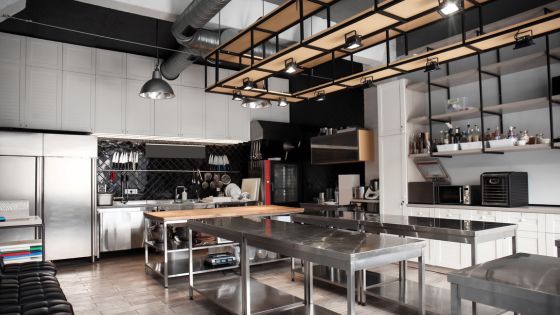Commercial kitchens should be well-organized to minimize physical stress for operational employees. It helps prevent back pain and fatigue and enables them to work efficiently for longer periods of time.
For example, the distance between the sink and the cooking area should be less than 1 m to reduce cross-contamination and ensure food hygiene. Ergonomic equipment and fittings are also designed to prevent awkward postures or repetitive movements, resulting in injuries.
Working Height
One of the most important aspects of ergonomic kitchen design is ensuring the correct working height. Having the right working height allows people to perform tasks without putting excessive strain on their bodies. This can help reduce the risk of developing musculoskeletal diseases such as rheumatoid arthritis and tendinitis.
Many kitchen tasks involve standing or bending over, which can cause back pain if done for long periods of time. Fortunately, commercial kitchen equipment designed to be ergonomic will improve the work experience for the staff. It will reduce the amount of time they spend doing a task, and it will also allow them to move more easily around the kitchen.
The way in which the kitchen features are arranged in your lot for sale will have an impact on how efficient the commercial kitchen is. The space between the appliances, cabinets, and sink is critical to a successful workflow.
For example, a dishwasher must be close to the sink and storage so that it is easy to load and unload. This will save time and energy. The same is true for cooklines and other food preparation areas. The ideal kitchen layout will allow staff to move easily from one station to another, speeding up the workflow and improving production efficiency.
Having the proper working height will also benefit the health of your staff. Standing in the same position all day can lead to lower back pain, joint stiffness, and overall muscle tiredness. Ergonomic seating helps to prevent these issues by providing a neutral posture, and by having a comfortable seat that supports the lower spine.
Considering the importance of working height and its role in reducing health problems, it is worth investing in ergonomic kitchen equipment to ensure that your business runs smoothly. It takes less time to do a task, eliminates unnecessary movement, and decreases physical strain on the staff, which all contribute to boosting employee morale in your restaurant. It will also help to reduce sick leave and workers’ compensation claims, which can be expensive for your business.
Space Between Workstations
The space between workstations must be sufficient for kitchens with multiple people working at one time. This allows staff members to move around the kitchen easily without worrying about stepping on or bumping into other employees’ feet. It also helps prevent back and foot pains that can be caused by standing for long periods of time in the same position.
Ideally, an employee should have a space of about three to four feet between the wall and their desk. This distance will allow them to reach items they may need from shelves or cabinets that are behind their desk. Similarly, a worker should have space in front of their desk to sit comfortably. This may seem like a small detail, but it can make a huge difference in the amount of strain that is put on an employee’s body while at work.
Another aspect to consider when determining the workspace is the required space for tools and equipment. Having adequate space to keep all the necessary items within arm’s reach helps reduce the need for unnecessary movement and decreases the risk of accidents in the kitchen. This can help prevent slips, burns, and cuts that could result from a lack of space to move and the overuse of certain muscles in the kitchen.
Commercial kitchen equipment with non-slip surfaces, tight grips, and simple controls helps prevent accidents in the kitchen while ensuring that employees can easily use their equipment safely. This can help reduce the need for sick leave due to postural discomfort and reduce food contamination and the risk of accidents from the overuse of certain muscle groups in the kitchen.
Incorporating ergonomic kitchen equipment into a commercial kitchen design improves employee morale by reducing stress and discomfort at work. This translates into higher job satisfaction, which ultimately leads to increased productivity and better results for the business. It is a simple way to show that you care about the health of your employees and are invested in the success of their careers.
Work Triangle
The kitchen work triangle is a principle that has helped people optimize their workflow for decades. The idea is to keep the three main kitchen elements (stove, sink, and refrigerator) close together so that they can be easily accessed at all times. This ensures that the cook can always move between these areas without wasting time and energy moving around the space.
The idea behind the work triangle is that a cook will typically make several trips between these three points while cooking, and having them all close to each other will allow them to make these movements as quickly as possible. This means that the cook will have to spend less time moving around the space, which in turn means they will be able to prepare and cook meals more quickly and efficiently.
In addition to reducing the time and effort required to complete tasks, the work triangle also helps prevent collisions between various appliances and other items in the kitchen. This is particularly important if more than one person is using the kitchen at any given time since it can be easy for people to get in each other’s way while working.
This concept was originally developed by Lillian Gilbreth, an industrial engineer, and psychologist who was a pioneer in workplace efficiency. It was rolled out at a women’s exposition in 1929 and then further developed in the 1940s by the University of Illinois School of Architecture before it became widely used in kitchen design.
While the work triangle is an important part of kitchen ergonomics, it can be difficult to implement in some kitchens. For example, it assumes that only one person will be cooking in the kitchen at any given time, which isn’t always the case in modern family homes.
In these situations, it may be a good idea to use a different layout for the kitchen or provide training on how to work safely and effectively in the space. Whether the work triangle is used in a commercial kitchen or a residential kitchen, it is a great starting point for optimizing workflows.
Floor
Using ergonomic kitchen equipment enables workers to work comfortably for extended periods of time and reduces back strain and other common health problems. It also boosts morale, improves job satisfaction, and fosters a positive work environment that makes employees feel valued for their efforts. Ergonomic commercial kitchen tools include commercial kitchen equipment handles designed to fit naturally in the hand, adjustable height workstations to suit individual needs, and controls positioned conveniently within reach. Ergonomic solutions also include commercial kitchen utensils that are lightweight for easy movement and help reduce the need to bend or stretch while performing tasks in the kitchen.
When designing a commercial kitchen, the layout and spacing of each station and piece of equipment is important because it affects how efficiently kitchen staff can perform their work. The ideal layout for a restaurant depends on the menu, target operations, and kitchen space.
For example, an L-shaped or galley kitchen arrangement is ideal for commercial restaurants because it maximizes the available space and optimizes the workflow of the kitchen. Galley kitchens are also great for reducing food spills, which can lead to food safety violations.
The layout of the kitchen should also take into account the number of different operations that are going to be carried out simultaneously in the restaurant. For example, the kitchen should have enough space for all staff members to move around freely without blocking each other. Moreover, the kitchen should have adequate storage space for all essentials and ingredients.
A well-designed commercial kitchen can save time and money for both the business and its employees. In addition, it helps prevent the occurrence of accidents and minimizes the risk of injuries. It is also important to ensure that the restaurant meets all health code requirements.
Ergonomics is a science that focuses on the relationship between human factors and machine design to ensure efficiency and comfort in the workplace. It also enhances employee morale and increases productivity by reducing the strain on body parts and increasing the speed of work. For this reason, commercial kitchen owners should be aware of the benefits of ergonomic design and implement it in their kitchens.




















